
Abbas Mirza was a Qajar crown prince of Iran. He developed a reputation as a military commander during the Russo-Persian War of 1804–1813 and the Russo-Persian War of 1826–1828, as well as through the Ottoman–Persian War of 1821–1823. He is furthermore noted as an early modernizer of Persia's armed forces and institutions, and for his death before his father, Fath Ali Shah.
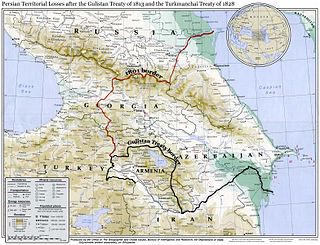
The Treaty of Gulistan was a peace treaty concluded between the Russian Empire and Qajar Iran on 24 October 1813 in the village of Gulistan as a result of the first full-scale Russo-Persian War. The peace negotiations were precipitated by the successful storming of Lankaran by General Pyotr Kotlyarevsky on 1 January 1813. It was the first of a series of treaties signed between Qajar Iran and Imperial Russia that forced Persia to cede the territories that formerly were part of Iran.

Prince Alexander of Georgia (1770–1844) was a Georgian royal prince (batonishvili) of the Bagrationi dynasty, who headed several insurrections against the Russian rule in Georgia. He was known as Eskandar Mīrzā (اسکندرمیرزا) in Persia, tsarevichAleksandr Irakliyevich in Russia, and Alexander Mirza in Western Europe.
The Russo-Persian Wars or Russo-Iranian Wars were a series of conflicts between 1651 and 1828, concerning Persia and the Russian Empire. Russia and Persia fought these wars over disputed governance of territories and countries in the Caucasus. The main territories disputed were Aran, Georgia and Armenia, as well as much of Dagestan – generally referred to as Transcaucasia – and considered part of the Safavid Iran prior to the Russo-Persian Wars. Over the course of the five Russo-Persian Wars, the governance of these regions transferred between the two empires. Between the Second and Third Russo-Persian Wars, there was an interbellum period in which a number of treaties were drawn up between the Russian and the Persian Empires, as well as between both parties and the Ottoman Empire. Ottoman interest in these territories further complicated the wars, with both sides forming alliances with the Ottoman Empire at different points throughout the wars. Following the Treaty of Turkmenchay, which concluded the Fifth Russo-Persian War, Persia ceded much of its Transcaucasian territory to the Russian Empire.
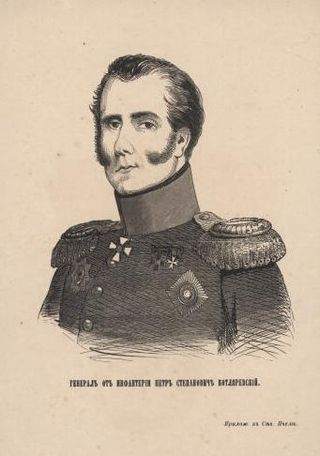
Pyotr Stepanovich Kotlyarevsky was a Russian military hero of the early 19th century.
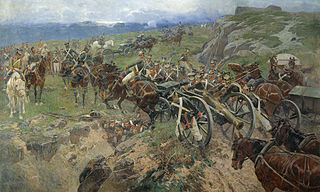
The Russo-Persian War of 1804–1813 was one of the many wars between the Persian Empire and Imperial Russia, and, like many of their other conflicts, began as a territorial dispute. The new Persian king, Fath Ali Shah Qajar, wanted to consolidate the northernmost reaches of his kingdom—modern-day Georgia—which had been annexed by Tsar Paul I several years after the Russo-Persian War of 1796. Like his Persian counterpart, the Tsar Alexander I was also new to the throne and equally determined to control the disputed territories.
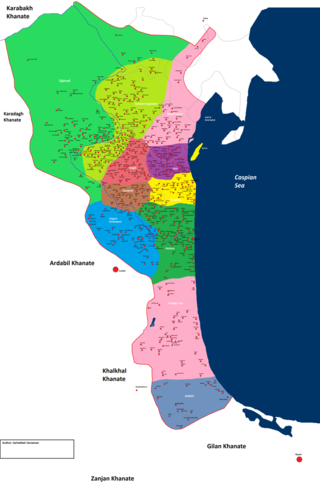
Talysh Khanate or Talish Khanate was an Iranian khanate of Iranian origin that was established in Afsharid Persia and existed from the middle of the 18th century till the beginning of the 19th century, located in the south-west coast of the Caspian Sea.

Shirvan Khanate was a Caucasian khanate under Iranian suzerainty, which controlled the Shirvan region from 1761 to 1820.

The Russo-Persian War of 1826–1828 was the last major military conflict between the Russian Empire and Qajar Iran, which was fought over territorial disputes in the South Caucasus region.
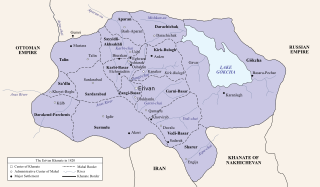
The Erivan Khanate, also known as Chokhur-e Sa'd, was a khanate that was established in Afsharid Iran in the 18th century. It covered an area of roughly 19,500 km2, and corresponded to most of present-day central Armenia, the Iğdır Province and the Kars Province's Kağızman district in present-day Turkey and the Sharur and Sadarak districts of the Nakhchivan Autonomous Republic of present-day Azerbaijan.

The Battle of Sultanabad occurred on February 13, 1812 between the Russian Empire and the Persian Empire. In the resulting battle, the Russians were routed.

The siege of Ganja or assault on Ganja was the result of a Russian offensive in the South Caucasus intended to conquer the Ganja Khanate of Qajar Iran, which contributed to the escalation of the Russo-Persian War (1804–1813).

Qajar Iran, also referred to as Qajar Persia, the Qajar Empire, Sublime State of Persia, officially the Sublime State of Iran and also known as the Guarded Domains of Iran, was an Iranian state ruled by the Qajar dynasty, which was of Turkic origin, specifically from the Qajar tribe, from 1789 to 1925. The Qajar family took full control of Iran in 1794, deposing Lotf 'Ali Khan, the last Shah of the Zand dynasty, and re-asserted Iranian sovereignty over large parts of the Caucasus. In 1796, Agha Mohammad Khan Qajar seized Mashhad with ease, putting an end to the Afsharid dynasty. He was formally crowned as Shah after his punitive campaign against Iran's Georgian subjects.
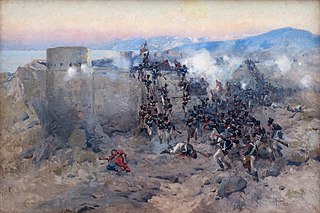
The siege of Lankaran took place from 7 January to 13 January 1813 during the Russo-Iranian War of 1804–1813. Lankaran, a city in the Talish region, was previously held by Mir-Mostafa Khan of the Talysh Khanate, a subject of Iran. However, due to his defiance, he was ousted from the city by Iranian forces in August 1812. Now directly held by the Iranians, the city was soon besieged by the Russian commander Pyotr Kotlyarevsky, who had recently defeated the Iranian crown-prince Abbas Mirza at the battle of Aslanduz.
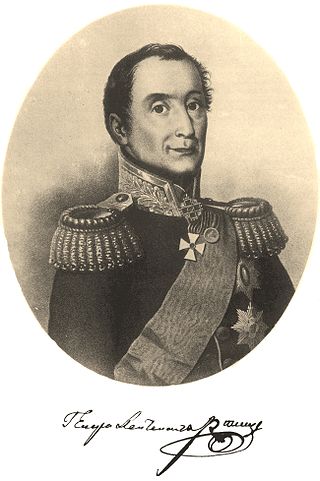
Nikolay Federovich Rtishchev was a General of the Infantry of the Russian Empire who served as the Russian Commander-in-chief in the Caucasus between 1812 and 1816. He is furthermore noted for being the Russian signatory to the Treaty of Gulistan which was concluded with Qajar Iran in 1813.
Mostafa Khan was the last khan of Shirvan, until 1820.
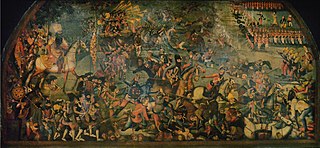
The siege of Erivan took place from July to September 1804, during the Russo-Persian War (1804–1813). After a difficult advance, the Russians under Pavel Tsitsianov besieged Erivan. The Iranian forces inside Erivan's citadel prevented the Russians from making a direct attack, while those outside the citadel surrounded the Russians and cut the invaders' supply lines. Commanded by Crown-Prince Abbas Mirza and King Fath-Ali Shah Qajar himself, the Iranians successfully defended the city and defeated the Russian attack. Tsitsianov, in order to save his reputation, shifted the blame on a plethora of people and matters, and deliberately left out his own wrongdoings.

The Battle of Echmiadzin took place in June 1804, during the Russo-Persian War of 1804–1813. A Russian force of 5,000 men under Pavel Tsitsianov advanced on Erivan. An Iranian army of 20,000 under Crown-Prince Abbas Mirza met him at Echmiadzin. Cutting off the Russian's supplies the Iranians successfully defended the town and forced the Russians to withdraw. Though the Russians were unable to capture Echmiadzin, the outcome of the battle itself has been variously described as inconclusive, an Iranian victory, or a Russian victory.
Charles Christie was a British officer, mostly remembered for his endeavours in Qajar Iran. A member of the first British military mission to Iran (1810), he was killed in action while serving on the Iranian side during the Russo-Persian War of 1804–1813.
Tālīsh is a region in the southwestern coast of the Caspian Sea. It is a homeland of the indigenous Talysh people, who inhabit the region and speak the Talysh language. The territory and the language set apart Talish from its neighbors.


















